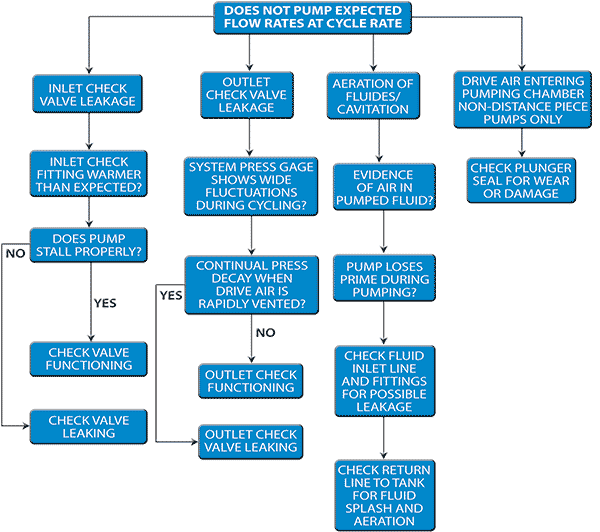Does Not Pump Expected Flow Rates at Cycle Rate

THEORY OF CAUSE:
Under normal operation of any positive displacement pump, the fluid that enters the pumping chamber must go out the outlet check valve into the system. This means that knowing "displacement per cycle" and "cycle rate", it is possible to reasonable predict the output flow. However, there are a number of conditions that can cause this output to be less than expected.
Inlet check valve leakage will permit some of the fluid to return to the fluid supply line during the pressure stroke. The greater the leakage rate, the more significant and noticeable the effect will be. If the pumping has been ongoing for a significant time, there could be a noticeable temperature increase on the inlet fitting as compared to the feed line. This is caused by the compression heating of the fluid, and the fact that the "heated" fluid is travelling back and forth through the inlet check valve along with the newly pumped fluid. Also, and easier method of detecting inlet check valve leakage is to stall the pump against pressure and see how much time it takes to make another cycle. The check valve is not designed to be an absolute shutoff, but it should hold for at least a minute or more between cycles. Most pump models, pumping petroleum based fluids, will hold for many times that long.
Outlet check valve leakage will permit system fluid to re-enter the pumping chamber during the pump suction stroke, resulting in less fluid being permitted to enter the chamber on each stroke. Again, the effect is proportional to the magnitude of the check valve leakage. The easiest way of detecting this leakage, is to pressurize the system to the desired pressure, and rapidly vent the air drive pressure. If the outlet check valve is sealing properly, there will be a small pressure drop and the pressure will remain constant for a significant period of time (the check valves are not designed to "hold" system pressure indefinitely). Gross leakage of the outlet check valve can prevent the pump from achieving its desired pressure, and the outlet pressure gage will experience a wide excursion of the needle with each cycle.
Aeration of the pumped fluid is another possible cause of loss in pumping ability. This aeration may be due to a leakage in the suction line permitting inhalation of air, or it may be due to the tank return line being above the fluid level. This will cause splashing and entrained air to enter the tank and mix with the rest of the fluid. Fluid return lines should always enter the tank below fluid level. When either of these conditions exist, it will usually be visible in the outlet fluid as a "milkiness" of the fluid, or it will be severe enough to cause a loss of prime.
An infrequent, but possible source of aeration, is drive air entering the pumping chamber by the plunger seal, since it is mainly a uni-directional seal. This can only happen on non-distance piece pumps. The condition can be caused by a damaged or excessively worn plunger seal on a distance piece pump, that can leak gas on the suction stroke, but not liquid on the pumping stroke.
